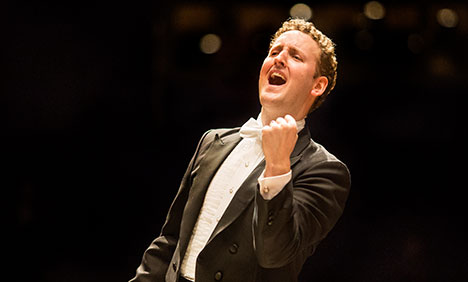by Timothy Robson

The weather did not hamper excellent music-making, however. The concert opened with Šárka: The Warrior Woman, the third movement of Smetana’s symphonic cycle Má Vlast (“My Homeland”). This movement describes Šárka, a woman scorned in love, who takes revenge on a group of knights. The music contrasts stormy, dramatic passages with strands of dance-like melodies. Here and throughout the concert, Francis drew well-formed phrasing and a clear musical line from the ensemble. Daniel McKelway played with lyrical sensitivity on the significant clarinet solo.
The Sinfonietta aside, Taras Bulba is Janáček’s best-known orchestral work. Composed from 1915-18 in the midst of the First World War, it is a three-movement “rhapsody for orchestra” based on a novella by Nikolai Gogol about a 16th-century Cossack officer attacking Poland.
The first movement opens with a long English horn solo, beautifully played by Robert Walters. Among the work’s numerous other solos, of special mention were the contributions by violinist Peter Otto. The music is often fragmentary, like an extended recitative, but alternating with passages of exquisite melodic beauty. In one striking moment, starkly dissonant music suddenly stops to reveal the undulating sustained chords of the organ.
After the first movement’s portrayal of the bloody conflict — and the brass fanfares reminiscent of Janáček’s Sinfonietta — the second movement’s shimmering music for harp and upper woodwinds soon becomes a depiction of the galloping horses in battle. The Poles celebrate capturing Taras Bulba’s eldest son Ostap with a folk dance. You can again hear violence in the third movement, about the capture and death of Taras Bulba, but eventually it ends with his vision of a victorious Russia, and music of eternal serenity.
This was a dramatic and precise performance — Michael Francis was clearly attuned to the quirky twists and dramatic colors built into Janáček’s score. Conductor and players wove the many fragments into a united whole, all aimed toward the final radiance of Taras Bulba’s death scene.
Dvořák’s “New World” Symphony is an audience favorite, but connoisseurs of his symphonies might choose the Seventh in d — performed on Sunday — as the greatest of the nine. It is well-proportioned, and infused with melodies and rhythms of the composer’s native Bohemia as well as forward-looking harmonic development.
The first movement was propulsive, but with a discernible sense of tension and release. In the second, Michael Francis interpreted the “Poco adagio” tempo on the fast side, contrasting in mood with the movement’s serene ending. The Scherzo was delicate, both swinging and sometimes receding, with a subtle transition to the central trio. Only the briefest pause separated the third and fourth movements, enabling no loss of tension or musical line. The great cello melody in the finale is one of the glories of Dvořák’s symphony, and The Cleveland Orchestra’s section did not disappoint.
Published on ClevelandClassical.com August 8, 2018.
Click here for a printable copy of this article


